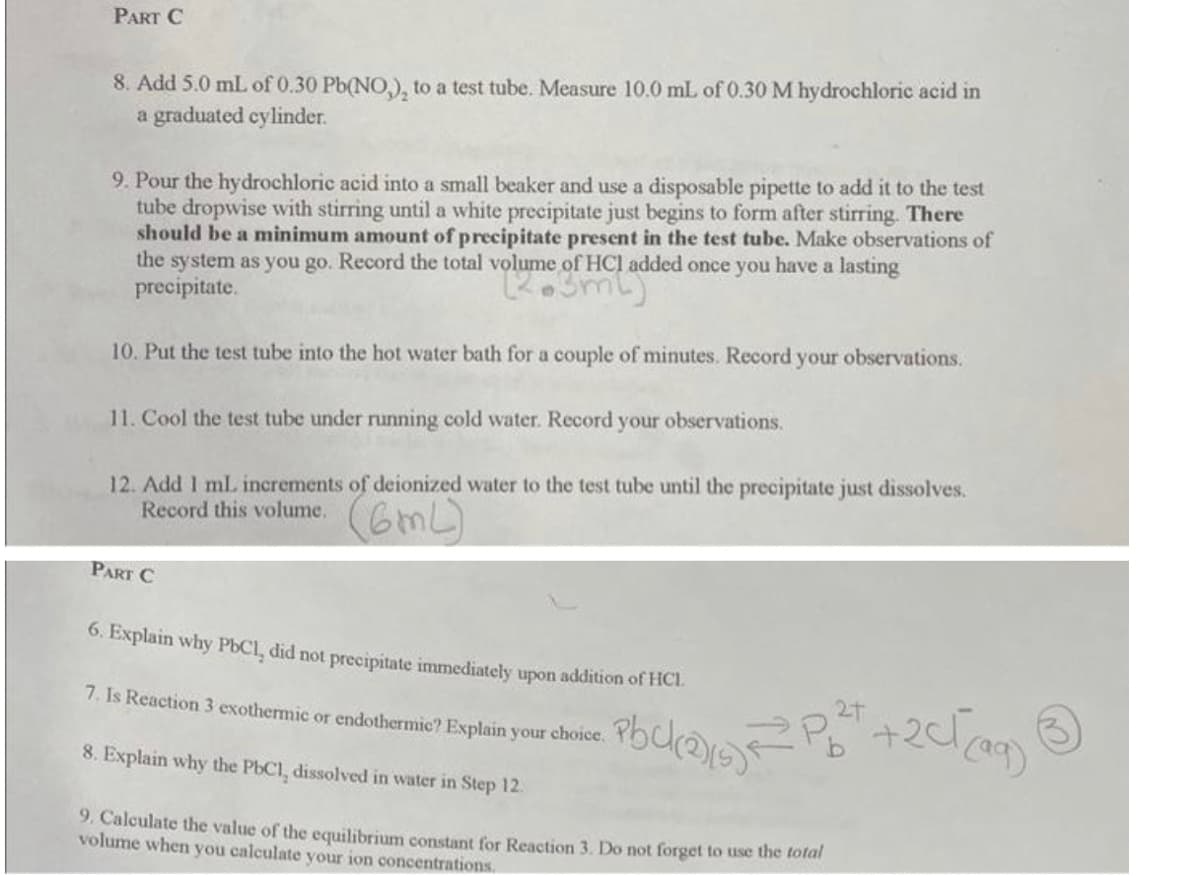Introductory Chemistry: A Foundation
9th Edition
ISBN:9781337399425
Author:Steven S. Zumdahl, Donald J. DeCoste
Publisher:Steven S. Zumdahl, Donald J. DeCoste
Chapter15: Solutions
Section: Chapter Questions
Problem 14ALQ
Related questions
Question
Explain step by step Q 9 by showing me the calculation please

Transcribed Image Text:PART C
8. Add 5.0 mL of 0.30 Pb(NO), to a test tube. Measure 10.0 mL of 0.30 M hydrochloric acid in
a graduated cylinder.
9. Pour the hydrochloric acid into a small beaker and use a disposable pipette to add it to the test
tube dropwise with stirring until a white precipitate just begins to form after stirring. There
should be a minimum amount of precipitate present in the test tube. Make observations of
the system as you go. Record the total volume of HCI added once you have a lasting
precipitate.
(2.3ml)
10. Put the test tube into the hot water bath for a couple of minutes. Record your observations.
11. Cool the test tube under running cold water. Record your observations.
12. Add 1 ml. increments of deionized water to the test tube until the precipitate just dissolves.
Record this volume.
(6mL)
PART C
6. Explain why PbC1, did not precipitate immediately upon addition of HCI.
7. Is Reaction 3 exothermic or endothermic? Explain your choice.
8. Explain why the PbC1, dissolved in water in Step 12.
9. Calculate the value of the equilibrium constant for Reaction 3. Do not forget to use the total
volume when you calculate your ion concentrations.
2+
• Pbck(2)/(s) = P₂²+ + 2√√(99)
Expert Solution
This question has been solved!
Explore an expertly crafted, step-by-step solution for a thorough understanding of key concepts.
Step by step
Solved in 2 steps

Knowledge Booster
Learn more about
Need a deep-dive on the concept behind this application? Look no further. Learn more about this topic, chemistry and related others by exploring similar questions and additional content below.Recommended textbooks for you

Introductory Chemistry: A Foundation
Chemistry
ISBN:
9781337399425
Author:
Steven S. Zumdahl, Donald J. DeCoste
Publisher:
Cengage Learning

Chemistry: An Atoms First Approach
Chemistry
ISBN:
9781305079243
Author:
Steven S. Zumdahl, Susan A. Zumdahl
Publisher:
Cengage Learning

Chemistry
Chemistry
ISBN:
9781305957404
Author:
Steven S. Zumdahl, Susan A. Zumdahl, Donald J. DeCoste
Publisher:
Cengage Learning

Introductory Chemistry: A Foundation
Chemistry
ISBN:
9781337399425
Author:
Steven S. Zumdahl, Donald J. DeCoste
Publisher:
Cengage Learning

Chemistry: An Atoms First Approach
Chemistry
ISBN:
9781305079243
Author:
Steven S. Zumdahl, Susan A. Zumdahl
Publisher:
Cengage Learning

Chemistry
Chemistry
ISBN:
9781305957404
Author:
Steven S. Zumdahl, Susan A. Zumdahl, Donald J. DeCoste
Publisher:
Cengage Learning


Chemistry: Principles and Practice
Chemistry
ISBN:
9780534420123
Author:
Daniel L. Reger, Scott R. Goode, David W. Ball, Edward Mercer
Publisher:
Cengage Learning

Introductory Chemistry: An Active Learning Approa…
Chemistry
ISBN:
9781305079250
Author:
Mark S. Cracolice, Ed Peters
Publisher:
Cengage Learning